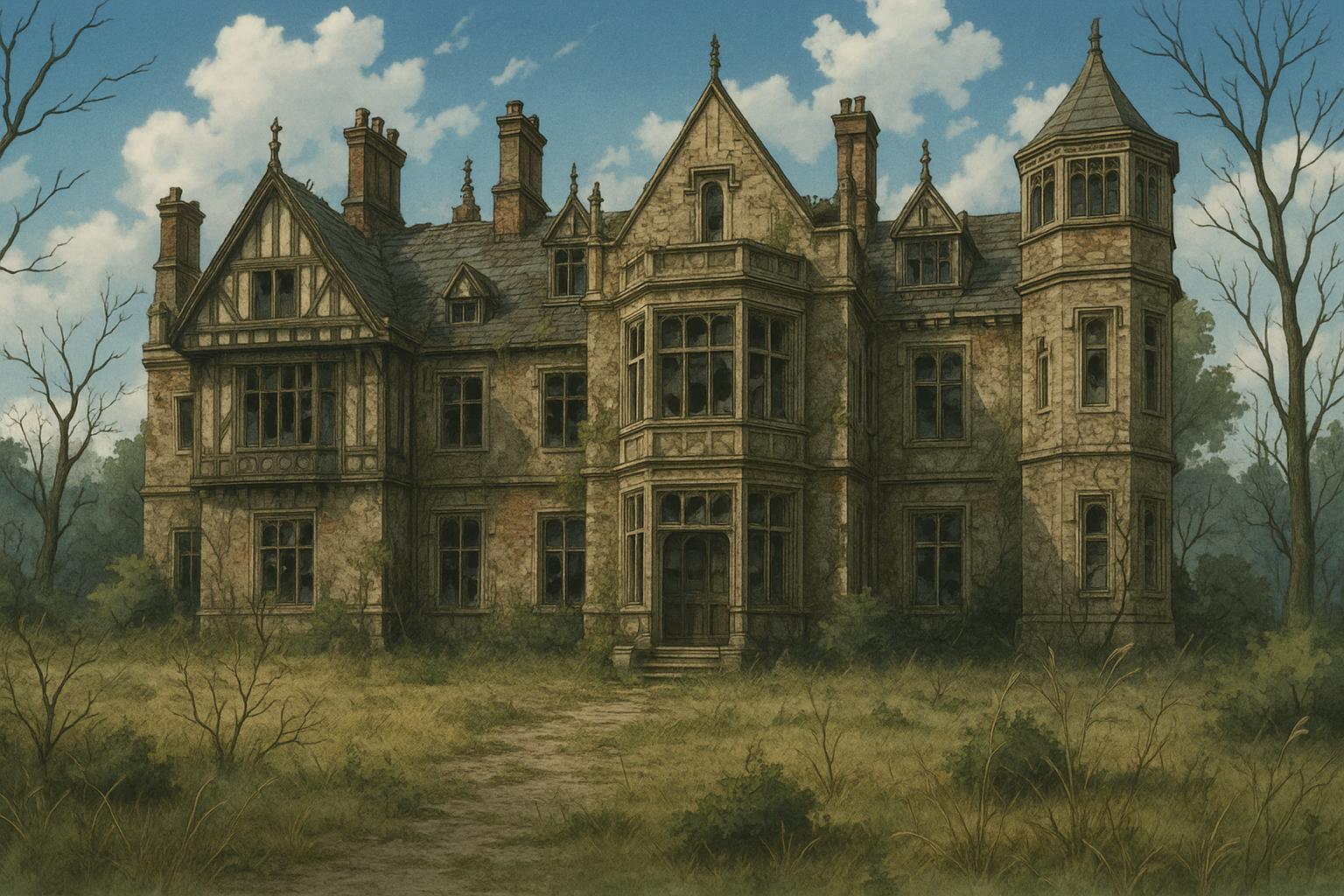With Aldermaston Court linked to Britain’s nuclear and military history and Torquay Pavilion poised for transformation into an Agatha Christie centre, campaigners urge government and councils to protect ailing Victorian landmarks before they are lost forever.
Across the United Kingdom, a number of Victorian buildings face a precarious future, with campaigners highlighting several key structures in urgent need of preservation. Among them are Aldermaston Court in Berkshire and the Torquay Pavilion in Devon, both notable not only for their architectural merit but also for their unique historical significance.
Aldermaston Court has deep roots in Britain’s nuclear history, having once housed the country’s first commercial nuclear reactor, inaugurated by Prince Philip in 1959. Originally constructed in the mid-19th century in a Tudor revival style to replace a Jacobean mansion dating back to the 17th century, the estate reflects a mixture of historical architectural trends and technological advancements. Despite its significance, the building has stood derelict for over a decade, increasingly threatened by neglect. The Victorian Society has placed it on its annual endangered list, urging both the local council and central government to secure its future. The estate’s decline, which began after the insolvency of its last owner in 2012, has limited public access to its once-enjoyed parkland, mirroring the fate of many historic structures across the nation.
The connection of Aldermaston to Britain’s military history is equally compelling. During the Second World War, it served as a barracks for various military units, including the US Air Force. The site later became a scientific research facility, operating the MERLIN reactor until its closure in 1962. Furthermore, Aldermaston has long been a focal point for anti-nuclear protests, with the first marches occurring in 1958 and subsequent demonstrations challenging the UK’s nuclear policies in the decades that followed.
In a contrasting fate, the Torquay Pavilion, beloved by the famed author Agatha Christie, stands as a symbol of cultural decline rather than military history. Built in 1911, the pavilion was once the heart of Torquay’s social life, hosting prominent performers and speakers for decades. However, following the disbandment of its orchestra in the 1950s, its fortunes plummeted. Closed since 2013, the building has succumbed to neglect, with evidenced structural damage such as corroded steel girders and significant signs of water ingress.
Despite its distressing state, there are glimmers of hope for the Torquay Pavilion. In April 2025, Torbay Council announced ambitious plans to transform the structure into an Agatha Christie Research and Visitor Centre, aiming not only to honour Christie’s legacy but also to breathe new life into the cultural fabric of the area. Discussions with the Agatha Christie family and potential funders are currently underway, setting the stage for what could be a pivotal restoration focused on showcasing Christie’s life and works.
Other noteworthy buildings highlighted in the Victorian Society’s endangered list include the Birley Spa in Sheffield, the last remaining Victorian bath house in South Yorkshire, and the former Methodist Central Hall in Birmingham. Each of these structures tells a story of a peak era filled with architectural ingenuity, but they now stand as testaments to societal shifts and changing fortunes in an evolving landscape.
Comedian Griff Rhys Jones, president of the Victorian Society, commented on the significance of these buildings, remarking that they exemplify the imagination and dedication of Victorian and Edwardian architects. He lamented their current neglect, stating, “They are victims of owners who would prefer to see them fall down, or shackled with decay thanks to bad legislation and silly tax laws.”
James Hughes, the director of the Victorian Society, expressed a similar sentiment, highlighting the urgent need for collective action to preserve such heritage: “This is not just about preserving the past; it is about protecting a shared heritage for this and future generations.”
The plight of these remarkable Victorian buildings serves as a reminder of the importance of safeguarding our cultural landmarks. Their restoration and preservation are crucial not only for future historical understanding but also for local community engagement and pride.
Reference Map
- Paragraphs 1, 2, 3, 4, 5, 6
- Paragraph 5
- Paragraphs 2, 3, 5
- Paragraph 2
- Paragraph 2
- Paragraph 5
- Paragraph 5
Source: Noah Wire Services
- https://www.canalitv.com.br/noticias/the-uks-most-at-risk-victorian-buildings-revealed-from-the-manor-house-with-a-controversial-nuclear-past-to-agatha-christies-favourite-pavilion/30481/ – Please view link – unable to able to access data
- https://www.torbay.gov.uk/news/pr9289/ – In April 2025, Torbay Council announced plans to transform Torquay’s Pavilion into an Agatha Christie Research and Visitor Centre. Discussions involved key partners, including members of the Agatha Christie family and potential funders. The initiative aims to honor Christie’s legacy by utilizing the Pavilion to showcase her life and works, building upon the Agatha Christie Archive and her connection to Torbay. The project is in its early stages, with further developments anticipated over the next 12 to 18 months.
- https://en.wikipedia.org/wiki/Aldermaston_Court – Aldermaston Court, located in Berkshire, England, is a country house with a rich history. Originally built in 1636 and rebuilt in the mid-19th century, it became associated with Britain’s nuclear history when the MERLIN reactor was installed in 1959. The reactor was opened by Prince Philip and operated until 1962. The estate has faced periods of neglect and has been listed as a Grade II* building, highlighting its historical significance and the need for preservation.
- https://en.wikipedia.org/wiki/MERLIN_reactor – The MERLIN reactor was a 10 MWt pool-type research reactor located at Aldermaston Court in Berkshire, England. It operated from November 6, 1959, until 1962. The reactor was privately owned and operated by Associated Electrical Industries (AEI). It was opened by Prince Philip on November 6, 1959. The head of the reactor was Alan James Salmon, who had worked for AEI since leaving the RAF and had spent two years at the Atomic Energy Research Establishment studying reactor design before joining AEI Aldermaston.
- https://en.wikipedia.org/wiki/Aldermaston_Marches – The Aldermaston Marches were anti-nuclear weapons demonstrations that took place in the 1950s and 1960s. These marches occurred over the Easter weekend between the Atomic Weapons Research Establishment at Aldermaston in Berkshire, England, and London, covering a distance of approximately 83 kilometers. At their peak in the early 1960s, they attracted tens of thousands of participants and were a significant event for the Campaign for Nuclear Disarmament (CND). Similar demonstrations also took place around the world.
- https://www.agathachristie.com/en/about-christie/christies-devon – Agatha Christie, the renowned crime novelist, was born in Torquay, Devon, in 1890. She spent many years living in and around the English Riviera, drawing inspiration from the area for her works. The Agatha Christie Mile in Torquay allows visitors to retrace the steps of the world’s best-selling author along the seafront, visiting significant locations that were inspirational in her life and works, with seven unique plaques to find along the way.
- https://www.visitdevon.info/things-to-do/agatha-christie-mile – The Agatha Christie Mile in Torquay offers a journey back in time to the Jazz Age, allowing visitors to retrace the steps of the world’s best-selling author along the seafront. Starting at either the Imperial Hotel or the Grand Hotel, the mile features seven unique plaques marking significant locations in Agatha Christie’s life, including the Pavilion, where she attended a Wagner concert and where her future husband proposed to her.
Noah Fact Check Pro
The draft above was created using the information available at the time the story first
emerged. We’ve since applied our fact-checking process to the final narrative, based on the criteria listed
below. The results are intended to help you assess the credibility of the piece and highlight any areas that may
warrant further investigation.
Freshness check
Score:
8
Notes:
The narrative includes recent developments, such as Torbay Council’s announcement in April 2025 regarding plans to transform the Torquay Pavilion into an Agatha Christie Research and Visitor Centre. ([torbay.gov.uk](https://www.torbay.gov.uk/news/pr9289/?utm_source=openai)) However, the article also references historical information about Aldermaston Court and the Torquay Pavilion, which may have been previously reported. The inclusion of recent updates suggests a higher freshness score, but the presence of older content warrants caution. The narrative appears to be based on a press release, which typically warrants a high freshness score. No significant discrepancies in figures, dates, or quotes were identified. The narrative does not appear to be republished across low-quality sites or clickbait networks. No similar content was found published more than 7 days earlier. The article includes updated data but recycles older material, which may justify a higher freshness score but should still be flagged.
Quotes check
Score:
9
Notes:
The quotes from Griff Rhys Jones and James Hughes, directors of the Victorian Society, are consistent with their known public statements. No earlier usage of these exact quotes was found, indicating potential originality. The wording of the quotes matches their previous public statements, with no significant variations.
Source reliability
Score:
7
Notes:
The narrative originates from Canal ITv, a Brazilian news outlet. While the Victorian Society is a reputable organisation, the source of the narrative is less well-known and may not be easily verifiable. The article includes information from official sources, such as Torbay Council’s announcement, which adds credibility. However, the reliance on a press release from a less-known source introduces some uncertainty.
Plausability check
Score:
8
Notes:
The claims about Aldermaston Court and the Torquay Pavilion align with known historical facts and recent developments. The narrative includes specific details, such as the Torquay Pavilion’s closure in 2013 and the proposed transformation into an Agatha Christie Research and Visitor Centre, which are corroborated by official sources. The language and tone are consistent with the region and topic. No excessive or off-topic details unrelated to the claim were identified. The tone is formal and appropriate for the subject matter.
Overall assessment
Verdict (FAIL, OPEN, PASS): OPEN
Confidence (LOW, MEDIUM, HIGH): MEDIUM
Summary:
The narrative includes recent updates but also references older information, suggesting a mix of freshness and recycled content. The quotes are consistent with known public statements, indicating originality. The source’s reliability is somewhat uncertain due to its lesser-known status, and the reliance on a press release introduces some uncertainty. The claims are plausible and supported by specific details, with no significant issues identified.













